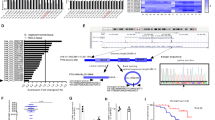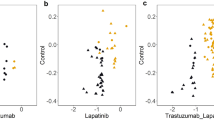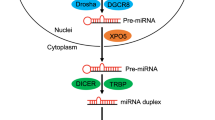Abstract
Non-steroidal anti-inflammatory drugs (NSAIDs) have been widely reported to display strong efficacy for cancer chemoprevention, although their mechanism of action is poorly understood. The most well-documented effects of NSAIDs include inhibition of tumor cell proliferation and induction of apoptosis, but their effect on tumor cell invasion has not been well studied. Here, we show that the NSAID, sulindac sulfide (SS) can potently inhibit the invasion of human MDA-MB-231 breast and HCT116 colon tumor cells in vitro at concentrations less than those required to inhibit tumor cell growth. To study the molecular basis for this activity, we investigated the involvement of microRNA (miRNA). A total of 132 miRNAs were found to be altered in response to SS treatment, including miR-10b, miR-17, miR-21 and miR-9, which have been previously implicated in tumor invasion and metastasis. We confirmed that these miRNA can stimulate tumor cell invasion and show that SS can attenuate their invasive effects by downregulating their expression. Employing luciferase and chromatin immunoprecipitation assays, NF-κB was found to bind the promoters of all four miRNAs to suppress their expression at the transcriptional level. We show that SS can inhibit the translocation of NF-κB to the nucleus by decreasing the phosphorylation of IKKβ and IκB. Analysis of the promoter sequences of the miRNAs suppressed by SS revealed that 81 of 115 sequences contained NF-κB-binding sites. These results show that SS can inhibit tumor cell invasion by suppressing NF-κB-mediated transcription of miRNAs.
This is a preview of subscription content, access via your institution
Access options
Subscribe to this journal
Receive 50 print issues and online access
$259.00 per year
only $5.18 per issue
Buy this article
- Purchase on Springer Link
- Instant access to full article PDF
Prices may be subject to local taxes which are calculated during checkout





Similar content being viewed by others
References
Smalley W, Ray WA, Daugherty J, Griffin MR . Use of nonsteroidal anti-inflammatory drugs and incidence of colorectal cancer: a population-based study. Arch Intern Med 1999; 159: 161–166.
Giardiello FM, Hamilton SR, Krush AJ, Piantadosi S, Hylind LM, Celano P et al. Treatment of colonic and rectal adenomas with sulindac in familial adenomatous polyposis. N Engl J Med 1993; 328: 1313–1316.
Beazer-Barclay Y, Levy DB, Moser AR, Dove WF, Hamilton SR, Vogelstein B et al. Sulindac suppresses tumorigenesis in the Min mouse. Carcinogenesis 1996; 17: 1757–1760.
Mahmoud NN, Boolbol SK, Dannenberg AJ, Mestre JR, Bilinski RT, Martucci C et al. The sulfide metabolite of sulindac prevents tumors and restores enterocyte apoptosis in a murine model of familial adenomatous polyposis. Carcinogenesis 1998; 19: 87–91.
Piazza GA, Alberts DS, Hixson LJ, Paranka NS, Li H, Finn T et al. Sulindac sulfone inhibits azoxymethane-induced colon carcinogenesis in rats without reducing prostaglandin levels. Cancer Res 1997; 57: 2909–2915.
Thompson HJ, Jiang C, Lu J, Mehta RG, Piazza GA, Paranka NS et al. Sulfone metabolite of sulindac inhibits mammary carcinogenesis. Cancer Res 1997; 57: 267–271.
Altuvia Y, Landgraf P, Lithwick G, Elefant N, Pfeffer S, Aravin A et al. Clustering and conservation patterns of human microRNAs. Nucleic Acids Res 2005; 33: 2697–2706.
Piazza GA, Rahm AL, Krutzsch M, Sperl G, Paranka NS, Gross PH et al. Antineoplastic drugs sulindac sulfide and sulfone inhibit cell growth by inducing apoptosis. Cancer Res 1995; 55: 3110–3116.
Hanif R, Pittas A, Feng Y, Koutsos MI, Qiao L, Staiano-Coico L et al. Effects of nonsteroidal anti-inflammatory drugs on proliferation and on induction of apoptosis in colon cancer cells by a prostaglandin-independent pathway. Biochem Pharmacol 1996; 52: 237–245.
Elder DJ, Halton DE, Hague A, Paraskeva C . Induction of apoptotic cell death in human colorectal carcinoma cell lines by a cyclooxygenase-2 (COX-2)-selective nonsteroidal anti-inflammatory drug: independence from COX-2 protein expression. Clin Cancer Res 1997; 3: 1679–1683.
Piazza GA, Rahm AK, Finn TS, Fryer BH, Li H, Stoumen AL et al. Apoptosis primarily accounts for the growth-inhibitory properties of sulindac metabolites and involves a mechanism that is independent of cyclooxygenase inhibition, cell cycle arrest, and p53 induction. Cancer Res 1997; 57: 2452–2459.
Rigas B, Shiff SJ . Is inhibition of cyclooxygenase required for the chemopreventive effect of NSAIDs in colon cancer? A model reconciling the current contradiction. Med Hypotheses 2000; 54: 210–215.
Kashfi K, Rigas B . Non-COX-2 targets and cancer: expanding the molecular target repertoire of chemoprevention. Biochem Pharmacol 2005; 70: 969–986.
Alberts DS, Hixson L, Ahnen D, Bogert C, Einspahr J, Paranka N et al. Do NSAIDs exert their colon cancer chemoprevention activities through the inhibition of mucosal prostaglandin synthetase? J Cell Biochem Suppl 1995; 22: 18–23.
Lundholm K, Gelin J, Hyltander A, Lonnroth C, Sandstrom R, Svaninger G et al. Anti-inflammatory treatment may prolong survival in undernourished patients with metastatic solid tumors. Cancer Res 1994; 54: 5602–5606.
Stein U, Arlt F, Smith J, Sack U, Herrmann P, Walther W et al. Intervening in beta-Catenin Signaling by Sulindac Inhibits S100A4-Dependent Colon Cancer Metastasis. Neoplasia 2011; 13: 131–144.
Eccles SA, Welch DR . Metastasis: recent discoveries and novel treatment strategies. Lancet 2007; 369: 1742–1757.
Bartel DP . MicroRNAs: genomics, biogenesis, mechanism, and function. Cell 2004; 116: 281–297.
Ambros V . The functions of animal microRNAs. Nature 2004; 431: 350–355.
Lewis BP, Burge CB, Bartel DP . Conserved seed pairing, often flanked by adenosines, indicates that thousands of human genes are microRNA targets. Cell 2005; 120: 15–20.
Lee HC, Park IC, Park MJ, An S, Woo SH, Jin HO et al. Sulindac and its metabolites inhibit invasion of glioblastoma cells via down-regulation of Akt/PKB and MMP-2. J Cell Biochem 2005; 94: 597–610.
Takamizawa J, Konishi H, Yanagisawa K, Tomida S, Osada H, Endoh H et al. Reduced expression of the let-7 microRNAs in human lung cancers in association with shortened postoperative survival. Cancer Res 2004; 64: 3753–3756.
Carmell MA, Xuan Z, Zhang MQ, Hannon GJ . The Argonaute family: tentacles that reach into RNAi, developmental control, stem cell maintenance, and tumorigenesis. Genes Dev 2002; 16: 2733–2742.
Karube Y, Tanaka H, Osada H, Tomida S, Tatematsu Y, Yanagisawa K et al. Reduced expression of Dicer associated with poor prognosis in lung cancer patients. Cancer Sci 2005; 96: 111–115.
Yu Z, Willmarth NE, Zhou J, Katiyar S, Wang M, Liu Y et al. microRNA 17/20 inhibits cellular invasion and tumor metastasis in breast cancer by heterotypic signaling. Proc Natl Acad Sci USA 2010; 107: 8231–8236.
Huang GL, Zhang XH, Guo GL, Huang KT, Yang KY, Shen X et al. Clinical significance of miR-21 expression in breast cancer: SYBR-Green I-based real-time RT-PCR study of invasive ductal carcinoma. Oncol Rep 2009; 21: 673–679.
Ma L, Reinhardt F, Pan E, Soutschek J, Bhat B, Marcusson EG et al. Therapeutic silencing of miR-10b inhibits metastasis in a mouse mammary tumor model. Nat Biotechnol 2010; 28: 341–347.
Ma L, Teruya-Feldstein J, Weinberg RA . Tumour invasion and metastasis initiated by microRNA-10b in breast cancer. Nature 2007; 449: 682–688.
Ma L, Young J, Prabhala H, Pan E, Mestdagh P, Muth D et al. miR-9, a MYC/MYCN-activated microRNA, regulates E-cadherin and cancer metastasis. Nat Cell Biol 2010; 12: 247–256.
Song B, Wang C, Liu J, Wang X, Lv L, Wei L et al. MicroRNA-21 regulates breast cancer invasion partly by targeting tissue inhibitor of metalloproteinase 3 expression. J Exp Clin Cancer Res 2010; 29: 29.
Zhu S, Wu H, Wu F, Nie D, Sheng S, Mo YY . MicroRNA-21 targets tumor suppressor genes in invasion and metastasis. Cell Res 2008; 18: 350–359.
Zhang Y, Yan LX, Wu QN, Du ZM, Chen J, Liao DZ et al. miR-125b is methylated and functions as a tumor suppressor by regulating the ETS1 proto-oncogene in human invasive breast cancer. Cancer Res 2011; 71: 3552–3562.
Ashkenazi A, Dixit VM . Death receptors: signaling and modulation. Science 1998; 281: 1305–1308.
Ryan KM, Ernst MK, Rice NR, Vousden KH . Role of NF-kappaB in p53-mediated programmed cell death. Nature 2000; 404: 892–897.
Thanos D, Maniatis T . NF-kappa B: a lesson in family values. Cell 1995; 80: 529–532.
Beg AA, Ruben SM, Scheinman RI, Haskill S, Rosen CA, Baldwin Jr AS . I kappa B interacts with the nuclear localization sequences of the subunits of NF-kappa B: a mechanism for cytoplasmic retention. Genes Dev 1992; 6: 1899–1913.
Brown K, Gerstberger S, Carlson L, Franzoso G, Siebenlist U . Control of I kappa B-alpha proteolysis by site-specific, signal-induced phosphorylation. Science 1995; 267: 1485–1488.
Shah SA, Volkov Y, Arfin Q, Abdel-Latif MM, Kelleher D . Ursodeoxycholic acid inhibits interleukin 1 beta [corrected] and deoxycholic acid-induced activation of NF-kappaB and AP-1 in human colon cancer cells. Int J Cancer 2006; 118: 532–539.
Mori N, Yamada Y, Ikeda S, Yamasaki Y, Tsukasaki K, Tanaka Y et al. Bay 11-7082 inhibits transcription factor NF-kappaB and induces apoptosis of HTLV-I-infected T-cell lines and primary adult T-cell leukemia cells. Blood 2002; 100: 1828–1834.
Zhou R, Hu G, Gong AY, Chen XM . Binding of NF-kappaB p65 subunit to the promoter elements is involved in LPS-induced transactivation of miRNA genes in human biliary epithelial cells. Nucleic Acids Res 2010; 38: 3222–3232.
Yamamoto Y, Yin MJ, Lin KM, Gaynor RB . Sulindac inhibits activation of the NF-kappaB pathway. J Biol Chem 1999; 274: 27307–27314.
Seo AM, Hong SW, Shin JS, Park IC, Hong NJ, Kim DJ et al. Sulindac induces apoptotic cell death in susceptible human breast cancer cells through, at least in part, inhibition of IKKbeta. Apoptosis 2009; 14: 913–922.
Jiang MC, Liao CF, Lee PH . Aspirin inhibits matrix metalloproteinase-2 activity, increases E-cadherin production, and inhibits in vitro invasion of tumor cells. Biochem Biophys Res Commun 2001; 282: 671–677.
Lee Y, Kim M, Han J, Yeom KH, Lee S, Baek SH et al. MicroRNA genes are transcribed by RNA polymerase II. Embo J 2004; 23: 4051–4060.
Cai X, Hagedorn CH, Cullen BR . Human microRNAs are processed from capped, polyadenylated transcripts that can also function as mRNAs. RNA 2004; 10: 1957–1966.
Xi Y, Shalgi R, Fodstad O, Pilpel Y, Ju J . Differentially regulated micro-RNAs and actively translated messenger RNA transcripts by tumor suppressor p53 in colon cancer. Clin Cancer Res 2006; 12: 2014–2024.
Taganov KD, Boldin MP, Chang KJ, Baltimore D . NF-kappaB-dependent induction of microRNA miR-146, an inhibitor targeted to signaling proteins of innate immune responses. Proc Natl Acad Sci USA 2006; 103: 12481–12486.
Loffler D, Brocke-Heidrich K, Pfeifer G, Stocsits C, Hackermuller J, Kretzschmar AK et al. Interleukin-6 dependent survival of multiple myeloma cells involves the Stat3-mediated induction of microRNA-21 through a highly conserved enhancer. Blood 2007; 110: 1330–1333.
He L, He X, Lim LP, de Stanchina E, Xuan Z, Liang Y et al. A microRNA component of the p53 tumour suppressor network. Nature 2007; 447: 1130–1134.
Fazi F, Rosa A, Fatica A, Gelmetti V, De Marchis ML, Nervi C et al. A minicircuitry comprised of microRNA-223 and transcription factors NFI-A and C/EBPalpha regulates human granulopoiesis. Cell 2005; 123: 819–831.
Chang TC, Yu D, Lee YS, Wentzel EA, Arking DE, West KM et al. Widespread microRNA repression by Myc contributes to tumorigenesis. Nat Genet 2008; 40: 43–50.
Bazzoni F, Rossato M, Fabbri M, Gaudiosi D, Mirolo M, Mori L et al. Induction and regulatory function of miR-9 in human monocytes and neutrophils exposed to proinflammatory signals. Proc Natl Acad Sci USA 2009; 106: 5282–5287.
O’Connell RM, Taganov KD, Boldin MP, Cheng G, Baltimore D . MicroRNA-155 is induced during the macrophage inflammatory response. Proc Natl Acad Sci USA 2007; 104: 1604–1609.
Rodriguez A, Griffiths-Jones S, Ashurst JL, Bradley A . Identification of mammalian microRNA host genes and transcription units. Genome Res 2004; 14: 1902–1910.
He L, Thomson JM, Hemann MT, Hernando-Monge E, Mu D, Goodson S et al. A microRNA polycistron as a potential human oncogene. Nature 2005; 435: 828–833.
Brown JW, Marshall DF, Echeverria M . Intronic noncoding RNAs and splicing. Trends Plant Sci 2008; 13: 335–342.
Saini HK, Griffiths-Jones S, Enright AJ . Genomic analysis of human microRNA transcripts. Proc Natl Acad Sci USA 2007; 104: 17719–17724.
Gefen N, Binder V, Zaliova M, Linka Y, Morrow M, Novosel A et al. Hsa-mir-125b-2 is highly expressed in childhood ETV6/RUNX1 (TEL/AML1) leukemias and confers survival advantage to growth inhibitory signals independent of p53. Leukemia 2010; 24: 89–96.
Nabel GJ, Verma IM . Proposed NF-kappa B/I kappa B family nomenclature. Genes Dev 1993; 7: 2063.
Hayden MS, Ghosh S . Shared principles in NF-kappaB signaling. Cell 2008; 132: 344–362.
Hurst DR, Edmonds MD, Welch DR . Metastamir: the field of metastasis-regulatory microRNA is spreading. Cancer Res 2009; 69: 7495–7498.
Liu S, Goldstein RH, Scepansky EM, Rosenblatt M . Inhibition of rho-associated kinase signaling prevents breast cancer metastasis to human bone. Cancer Res 2009; 69: 8742–8751.
Li H, Bian C, Liao L, Li J, Zhao RC . miR-17-5p promotes human breast cancer cell migration and invasion through suppression of HBP1. Breast Cancer Res Treat 2011; 126: 565–575.
Selcuklu SD, Donoghue MT, Spillane C . miR-21 as a key regulator of oncogenic processes. Biochem Soc Trans 2009; 37: 918–925.
Slaby O, Svoboda M, Fabian P, Smerdova T, Knoflickova D, Bednarikova M et al. Altered expression of miR-21, miR-31, miR-143 and miR-145 is related to clinicopathologic features of colorectal cancer. Oncology 2007; 72: 397–402.
Iorio MV, Ferracin M, Liu CG, Veronese A, Spizzo R, Sabbioni S et al. MicroRNA gene expression deregulation in human breast cancer. Cancer Res 2005; 65: 7065–7070.
Bandres E, Agirre X, Bitarte N, Ramirez N, Zarate R, Roman-Gomez J et al. Epigenetic regulation of microRNA expression in colorectal cancer. Int J Cancer 2009; 125: 2737–2743.
Piazza GA, Keeton AB, Tinsley HN, Gary BD, Whitt JD, Mathew B et al. A novel sulindac derivative that does not inhibit cyclooxygenases but potently inhibits colon tumor cell growth and induces apoptosis with antitumor activity. Cancer Prev Res (Phila) 2009; 2: 572–580.
Agarwal B, Swaroop P, Protiva P, Raj SV, Shirin H, Holt PR . Cox-2 is needed but not sufficient for apoptosis induced by Cox-2 selective inhibitors in colon cancer cells. Apoptosis 2003; 8: 649–654.
Singh B, Berry JA, Shoher A, Lucci A . COX-2 induces IL-11 production in human breast cancer cells. J Surg Res 2006; 131: 267–275.
Xi Y, Nakajima G, Gavin E, Morris CG, Kudo K, Hayashi K et al. Systematic analysis of microRNA expression of RNA extracted from fresh frozen and formalin-fixed paraffin-embedded samples. RNA 2007; 13: 1668–1674.
Wang B, Howel P, Bruheim S, Ju J, Owen LB, Fodstad O et al. Systematic Evaluation of Three microRNA Profiling Platforms: Microarray, Beads Array, and Quantitative Real-Time PCR Array. PLoS One 2011; 6: e17167.
Varkonyi-Gasic E, Wu R, Wood M, Walton EF, Hellens RP . Protocol: a highly sensitive RT-PCR method for detection and quantification of microRNAs. Plant Methods 2007; 3: 12.
Acknowledgements
This study was supported by the institutional start-up funding (Dr Yaguang Xi) and the National Cancer Institute grant R01CA148817 (Dr Gary A Piazza). We sincerely appreciate Mrs Margaret Sullivan for proof-reading the manuscript.
Author information
Authors and Affiliations
Corresponding author
Ethics declarations
Competing interests
The authors declare no conflict of interest.
Additional information
Supplementary Information accompanies the paper on the Oncogene website
Supplementary information
Rights and permissions
About this article
Cite this article
Li, X., Gao, L., Cui, Q. et al. Sulindac inhibits tumor cell invasion by suppressing NF-κB-mediated transcription of microRNAs. Oncogene 31, 4979–4986 (2012). https://doi.org/10.1038/onc.2011.655
Received:
Revised:
Accepted:
Published:
Issue Date:
DOI: https://doi.org/10.1038/onc.2011.655
Keywords
This article is cited by
-
Dysregulation of noncoding RNA in chordoma; implications in identifying potential targets for novel therapeutic approaches
Molecular Biology Reports (2024)
-
Itaconate promotes hepatocellular carcinoma progression by epigenetic induction of CD8+ T-cell exhaustion
Nature Communications (2023)
-
Elevated expression of the rhythm gene NFIL3 promotes the progression of TNBC by activating NF-κB signaling through suppression of NFKBIA transcription
Journal of Experimental & Clinical Cancer Research (2022)
-
MicroRNAs are involved in the development and progression of gastric cancer
Acta Pharmacologica Sinica (2021)
-
Reduction in MicroRNA-4488 Expression Induces NFκB Translocation in Venous Endothelial Cells Under Arterial Flow
Cardiovascular Drugs and Therapy (2021)



